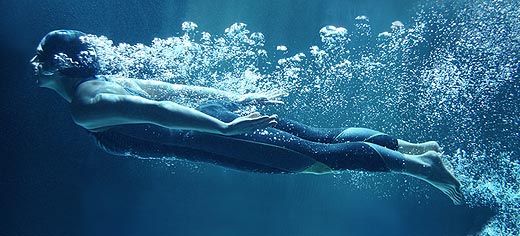
Fabric used to make what is believed to be the fastest swimsuit to ever go on the market was tested by Leeds researchers who simulated conditions close to those experienced by elite swimmers.
A team led by Sedimentologist Professor Jeff Peakall developed a methodology using lasers and flume tanks contained in a giant black box to accurately measure the speed of fabric through water. They were commissioned by swimwear company Speedo to assist in the development of its new FASTSKIN3 Racing System™ swimsuit. Professor Peakall and colleagues Professor Dan Parsons (now at the University of Hull), Dr Gareth Keevil and Russ Dixon spent 18 months testing levels of "fabric drag" - the measure of how efficiently fabric moves through water. The project saw Professor Peakall and Professor Parsons work in conjunction with Speedo's in-house global research and development facility, Aqualab -- with elite level athletes and coaches, sports scientists, global hydrodynamics experts and optical engineers around the world also contributing to the extensive product development process. Professor Peakall said: "We're really excited because I think we've found out that some of the materials are appreciably faster than anything we've seen before, and I'm absolutely confident that this is going to be of great benefit to competitive swimmers." The scientists used a powerful recirculating flume to move a large body of water through about 50 fabric samples to simulate the speed of an internationally competitive swimmer. At the same time, they operated a laser machine -- similar to a police speed trap - to measure hundreds of velocity points around each piece of fabric, to detect how the water flow changed over the material. Professor Peakall said: "The interaction of water with a material is surprisingly complex and ideally you want water to move over it as smoothly as possible, rather than in a chaotic manner where the water is mixing and generating lots of swirls in the flow." Computer Generated Imagery, the same 3D scanning technology used in Hollywood films, was then used by Speedo to test how fabrics behaved when worn by people.The scientists also examined how fabric changes over time in order to identify a material that has low fabric drag even after a long period in the water -- key for longer distance swimmers.
More information
Contact: University of Leeds Communications & Press Office: Tel +44 (0)113 343 4031, email pressoffice@leeds.ac.uk
The scientists tested the fabric at the University of Leeds' Sorby Environmental Fluid Dynamics Laboratory, the national centre for research into environmental fluid dynamics.